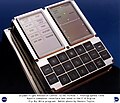ファイル:Apollo display and keyboard unit (DSKY) used on F-8 DFBW DVIDS683588.jpg

このプレビューのサイズ: 765 × 600 ピクセル。 その他の解像度: 306 × 240 ピクセル | 612 × 480 ピクセル | 980 × 768 ピクセル | 1,280 × 1,004 ピクセル | 2,560 × 2,007 ピクセル | 3,030 × 2,376 ピクセル。
元のファイル (3,030 × 2,376 ピクセル、ファイルサイズ: 6.18メガバイト、MIME タイプ: image/jpeg)
ファイルの履歴
過去の版のファイルを表示するには、その版の日時をクリックしてください。
| 日付と時刻 | サムネイル | 寸法 | 利用者 | コメント | |
|---|---|---|---|---|---|
| 現在の版 | 2021年10月9日 (土) 06:29 |  | 3,030 × 2,376 (6.18メガバイト) | Huntster | Cropped 9 % vertically using CropTool with lossless mode. |
| 2021年10月9日 (土) 06:28 |  | 3,030 × 2,606 (5.97メガバイト) | Huntster | Full resolution from NASA. | |
| 2015年5月6日 (水) 00:42 |  | 1,536 × 1,321 (303キロバイト) | Fæ | == {{int:filedesc}} == {{milim | description = {{en|1=The display and keyboard (DSKY) unit used on the F-8 Digital Fly-By-Wire (DFBW) aircraft during Phase I of the fly-by-wire program. Warning lights are in the upper left section, displays in the uppe... |
ファイルの使用状況
以下のページがこのファイルを使用しています:
グローバルなファイル使用状況
以下に挙げる他のウィキがこの画像を使っています:
- ar.wikipedia.org での使用状況
- en.wikipedia.org での使用状況
- es.wikipedia.org での使用状況
- fi.wikipedia.org での使用状況
- fr.wikipedia.org での使用状況
- he.wikipedia.org での使用状況
- hu.wikipedia.org での使用状況
- pl.wikipedia.org での使用状況
- ru.wikipedia.org での使用状況
- uk.wikipedia.org での使用状況

